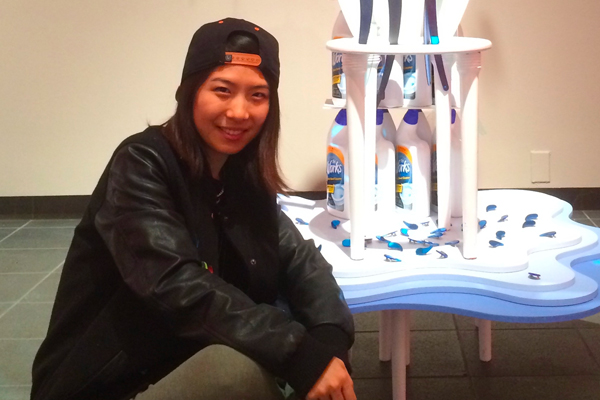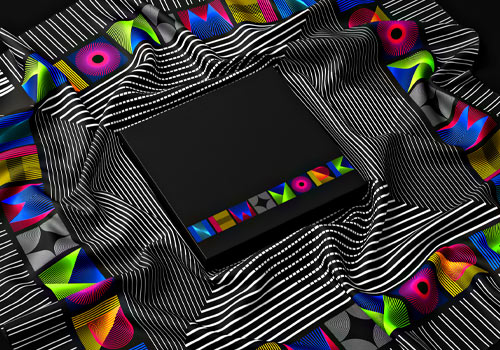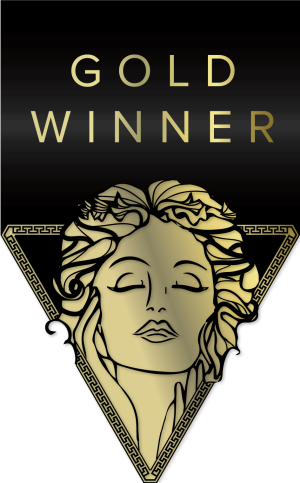
Interview
Qiushuo Li
United States
Qiushuo Li, with a Master's in Design from the School of Visual Arts, currently channels her passion for branding and user experience as an Interactive Designer at The Washington Post. Her diverse professional background in advertising, publishing, and digital product design has shaped her into a problem solver known for both open-mindedness and attention to detail.
1 Please give us a brief bio of yourself and your creative background.
Holding a Master's degree in Design from the School of Visual Arts, I am currently channeling my passion for branding and user experience into my role as an Interactive Designer at The Washington Post. My studies in computer arts in college provided me with a wide-ranging palette of knowledge. My professional journey through advertising, publishing, and digital product design shaped me as a problem solver who is both open-minded and detail-oriented.
2 What made you become/why did you choose to become a creative?
My creative spark was ignited by the anime I watched as a child. The imaginative outfits of the characters enthralled me, leading me to spend countless hours creating my own characters and meticulously drawing their costumes. This wasn't merely a pastime
3 Tell us more about your business/company, job profile, and what you do.
I currently hold a full-time position at The Washington Post as an Interactive Designer for branded content. This role demands versatility, encompassing responsibilities in graphic design, UX/UI design, strategy, animation, and art direction. My past experiences and accumulated knowledge have provided a robust foundation that supports my capabilities in this multifaceted job. Outside of my professional work, I invest my free time in personal projects that challenge conventional visual expression. Engaging in experimental work, I maintain a fresh and curious approach to design. My multi-disciplinary background has shaped my belief in the interconnectedness and mutual support of different disciplines. My particular fascination lies with typography, where I relish in blending diverse disciplines to explore new creative possibilities.
4 What does “creativity” mean to you?
Creativity, for me, is the daring and inquisitive drive to step into uncharted territories. It's an inherent quality that everyone possesses to some degree. To be creative is to widen one
5 To you, what makes a “creative” idea and/or design?
A truly creative idea or design is distinguished by its underlying intention and concept. It's characterized by its originality and boldness, representing something unprecedented that challenges conventional thinking. Consider Apple as an illustration: the continuous technological enhancements in their products don't always equate to creativity. Rather, it was Steve Jobs' audacity to challenge conventions and bring forth revolutionary designs and user experiences that truly embodied creativity. Jobs didn't cater to the prevailing industry standards or consumer expectations but instead trusted his vision, creating products that didn't just meet demands
6 Tell us about your creative and/or design process.
My design process varies depending on the project's nature, oscillating between experimental artistry and practical problem-solving. For experimental designs, the process is intuitive and driven by a single spark of inspiration. It involves exploring various approaches to express an idea visually, pushing the boundaries of what's possible. Business-oriented design follows a more methodical approach. It kicks off with a client's brief that clearly defines the issue at hand or the objective to be met. This route is both cooperative and deliberate, demanding a deep dive into the brand's ethos, pinpointing the target demographic, and crafting the most engaging user interactions. Creativity and aesthetics are essential, but they must align with the strategic confines of market trends, audience needs, financial constraints, and platform suitability. While design is just one piece of the puzzle, its excellence is crucial for impactful message delivery and achieving significant results.
7 What's your favorite part of the creative process and why?
My favorite stage in the creative process is undoubtedly ideation and brainstorming. This phase is exhilarating as it allows me to fully unleash my imagination and explore the vast potential of design without constraints. It's a time when I can push boundaries and entertain the wildest of ideas, setting the stage for innovative and groundbreaking work.
8 Describe your creative style and its main characteristics.
My creative style is deeply rooted in my background in computer arts, which has shaped me into a designer who prioritizes thought and structure over sentiment. I have a keen sensitivity to geometric forms over textures, steering my passion toward brand design and typography. I'm particularly captivated by the graphics that emerge from computational processes, especially when orchestrating a symphony of multiple elements. Consider the visual spectacle of letters scattering in the wind from a page
9 Do you think your country and its cultural heritage has an impact on your creativity process?
My creativity is certainly influenced by a dual cultural understanding, having moved from China to NYC. The shift didn't just change my aesthetic preferences but profoundly expanded my thinking. It's the ability to view things from varied perspectives that's been most impactful. My exposure to both Eastern and Western cultures has enriched my understanding of diverse viewpoints and thought processes. It's taught me that issues often exist in shades of gray rather than black and white. A solution may serve one person well yet have unintended consequences for the larger community, and what seems beneficial in the short term could have a different impact when viewed over a longer period. For instance, electric cars are celebrated for lowering air pollution now, but the long-term environmental risks posed by their batteries present a complex challenge. This awareness makes me more open-minded towards various viewpoints and artistic expressions.
10 Congratulations! As the winner of the 2023 MUSE Creative Awards, what does it mean to you and your company and team to receive this award distinction?
The award is not just a trophy or a title; it's a reminder of the countless hours of dedication and the commitment to my craft that often goes unseen. It's gratifying to know that my efforts to push boundaries and innovate within the design world are appreciated and celebrated. This accolade motivates me to continue exploring, experimenting, and evolving as a designer, aiming to create work that elicits emotion and thought.
11 Can you explain a bit about the winning work you entered into the 2023 MUSE Creative Awards, and why you chose to enter this project?
BEAM is a typographic reflection of the city at night, mirroring its vibrant pulse through meticulous linework and geometric precision. Inspired by the interplay of laser lights and the energetic atmosphere of urban evenings, it infuses the liveliness of nightlife into the structure of letters. More than just an aesthetic statement, BEAM investigates the functionality of typography. It challenges the norms, exploring how two-dimensional characters can engage within a three-dimensional context. I submitted BEAM to the MUSE Creative Awards to spotlight its unique qualities, setting it apart from my usual work. This typeface embodies a more liberated and experimental take on typography, and I was keen to initiate discussions about exploring letters in innovative formats and dimensions.
12 What was the biggest challenge with this project?
The most significant challenge in crafting BEAM was ensuring its visual integrity at different scales. On larger displays, an array of thin lines creates intricate craftsmanship, but at smaller sizes, these lines can merge and appear as solid blocks of color. To address this, I had to meticulously adjust the line count, weight, and density relative to the font size. I'm delving into creative coding to evolve BEAM into a variable font system that intelligently adapts line thickness and number to match how large or small the font is displayed. Looking to the future, I envision expanding BEAM's presence into three-dimensional spaces, perhaps through laser light projections at large-scale events, which would offer a novel, experiential interpretation of the typeface.
13 How has winning an Award developed your practice/career?
Winning the Muse Creative Awards has been a pivotal achievement, significantly raising my profile in the creative community and spotlighting my work, which has opened doors to new and thrilling opportunities. This exposure extends beyond simple recognition; it has cultivated meaningful connections with professionals globally, enriching my network and creating robust platforms for dialogue and collaboration. The honor of being recognized by such a prestigious institution has further motivated me to push the boundaries of creativity and pursue originality in my work. It
14 What are your top three (3) favorite things about our industry?
My top favorite aspect of the creative industry is undoubtedly the nature of the work itself. When I'm deeply engaged in a project, it doesn't feel like a task but rather like an invigorating pastime. Time seems to fly as I immerse myself in the design process, and there's an immense sense of fulfillment that comes from crafting pieces that embody my spirit. It's deeply satisfying to know that my creations not only encapsulate my essence but also contribute to the wider world, allowing me to leave a mark and amplify my voice. Secondly, the people in the creative industry are a significant part of why I cherish this field. There's a unique comfort in interacting with fellow creatives who are not only humble and empathetic but also genuinely authentic. I find their purity of heart and enduring curiosity for the world around us incredibly inspiring. They approach life with a spirit-first mindset rather than a materialistic one, resonating deeply with me and encouraging me to stay true to my core values and aspirations. Lastly, the flexibility inherent in the creative industry is something I deeply value. As a visual designer, the liberty to work from virtually anywhere allows me to draw inspiration directly from the world around me, feeding my creativity with experiences that can't be taught in a classroom. This constant interaction with diverse environments and cultures keeps my work fresh and my ideas innovative, reminding me that true inspiration is often found in the spontaneity of life itself.
15 What makes your country specifically, unique in the creative industry?
China's creative ethos is introspective. There's a cultural inclination towards humility and contemplation, with a preference for deep thought over conversation. This introspection prioritizes the 'why' behind actions, which resonates in the design landscape where the emphasis is on the end result rather than the method. Furthermore, the Chinese value for family and community naturally extends into design, manifesting in the creation of comprehensive and interconnected systems. Although the US is not my native country, its distinctive creative culture has significantly influenced my work. Here, the creative approach is characterized by a hands-on, explorative spirit. The focus is on the 'do', on action and experimentation, as captured in the adage 'fake it until you make it'. This mindset nurtures confidence and optimism, encouraging individuals to find merit in every attempt, even from unsuccessful endeavors. Such tolerance for trial and error is not just uplifting; it is instrumental in fostering a myriad of diverse and vibrant artistic expressions.
16 If you were a student entering this industry or an aspiring MUSE Creative Awards submitter, what advice would you give them?
First and foremost, be true to yourself. Let your work authentically reflect who you are instead of merely chasing trends or the allure of a hefty paycheck. Success measured solely by external standards may not align with personal fulfillment. The creative industry requires more than talent; it calls for relentless dedication and a deep-seated passion. Significant sacrifices often accompany this commitment. When passion is your driving force, it transforms into the power that ignites your creativity, giving you the strength to navigate the toughest challenges with unwavering resilience.
17 What resources would you recommend to someone who wants to improve their skills in the creative industry?
To improve skills in the creative industry, I recommend a blend of social media engagement and education. Follow and interact with admired artists on platforms like Instagram and Behance, and take advantage of online courses offered by sites like Skillshare and Coursera. Regularly attend workshops and design events for hands-on experience and networking. Supplement these experiences with insightful design lectures, podcasts, and books to deepen our understanding of design principles. Continuous practice and staying informed are crucial for growth in this ever-evolving field.
18 Who has inspired you in your life and why?
Eric, my first creative director at an ad agency, has been a significant inspiration in my life. He was more than a manager; he was a mentor who introduced me to the broader and more nuanced aspects of design and creativity. Fresh out of college, my skills were technical, but Eric taught me the value of a strong, central idea in design, showing me that technique without substance is hollow. His exacting approach and attention to detail shaped me into a top-tier designer, instilling a work ethic focused on quality and depth. This discipline has been crucial in my career achievements and continues to guide me in my professional journey.
19 What is your key to success? Any parting words of wisdom?
While I believe it's still early to define my journey as a success, if there's one key I hold on to, it's persistence. Life is a series of ups and downs, and it's perfectly alright to find oneself in the troughs occasionally. My approach isn't to rush out of these lows, but to embrace and learn from them, knowing they're temporary. The determination to rise each time I fall has turned challenging times into valuable adventures. Resilience is my mantra, and it

